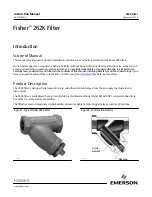
EVOLUTION-RO1000 Reverse Osmosis System
Installation and Maintenance Manual
SAFETY GUIDES
Read and follow all steps and guides carefully before installing and
using your reverse osmosis system. The included Quick Start Guide is
only a basic guide to help you through the initial setup of the system.
Please read this more detailed manual before running the system.
Do not use this product to make safe drinking water from non-potable
water sources. Do not use the system on microbiologically unsafe
water, or water of unknown quality without adequate disinfection
before or after the system.
This reverse osmosis system contains replaceable components
(membrane elements). These components are critical for the
effective reduction of total dissolved solids and specific
contaminants.
The Reverse Osmosis System does not have a monitoring device for
contaminants. To verify that the system is performing satisfactorily
the product water should be tested periodically by the system’s
installing dealer or a certified laboratory, every six months. The
laboratory should be certified for testing the specific contaminants of
concern. For a listing of certified laboratories, contact local regulatory
agencies or Hydro-Logic. Within the United States, many state-run
Department of Natural Resources or Department of Health Services
maintain listings of certified laboratories.
The optional TDS Monitor can be used to monitor incoming tap water
and outgoing purified water PPM (Parts Per Million) of TDS (total
dissolved solids).
Consult your local public works department for plumbing and
sanitation codes. Follow your local codes if they differ from this
manual.
The reverse osmosis system works on water pressures of 40 psi
(2.8 bar) minimum to 80 psi (5.5 bar) maximum. Water pressure can
be reduced by installing a pressure reducing valve in the water
supply pipe to the RO system. A booster pump should be used for low
pressure applications. Both are available through your dealer
or Hydro-Logic.
Do not install the reverse osmosis system in extreme hot or cold
temperatures. Temperature of the water supply to the reverse
osmosis system must be between 40°F (4°C) and 100°F (38°C).
Do not install on hot water lines.
The reverse osmosis membranes contain a foodgrade preservative
for storage and shipment. All new membranes require a minimum 2
hour rinse to properly rinse out the preservative. The preservative
is not harmful but makes the product water taste objectionable.
Rinsing the membrane also acts as a performance conditioner. All
new membranes will reach their stable maximum performance after 8
hours of rinsing.
THE BASIC REVERSE OSMOSIS SYSTEM
Your Reverse Osmosis System is a water treatment unit. It uses water
pressure to reverse a natural physical process called osmosis. Water,
under pressure, is forced through a semi-permeable membrane to
filter out minerals and impurities. Treated drinking water goes through
the blue line. Minerals and impurities are sent to the drain with RO
waste water through the black line.
The system includes a replaceable carbon pre-filter and 2 membrane
elements. The pre-filter reduces sand, silt, dirt, rust particles, other
sediments, chlorine, chloramines, iron and sulfur from the incoming
water supply before they enter the RO membrane elements. An
optional high capacity pre-filter, the Pre-Evolution, is available to
add 2 extra stages of pre-filtration. This will help further reduce the
contaminants listed above as well as cut down on filter changes and
maintenance of the Evolution-RO1000. An optional De-Ionization
post-filter will remove any remaining PPM of TDS in the water after
passing through the RO system.
BEFORE INSTALLING THE RO SYSTEM
Best performance of the system will be achieved when the
•
incoming water has been pre-treated.
The water coming into the system must be within certain limits
•
for sediments, pressure, etc. Refer to the specifications to
determine if your installation is within the limits.
A water quality analysis can be performed to determine if
•
incoming water requires any treatment. Contact your dealer/
installer or Hydro-Logic.
The filters and membrane elements in the RO system need
•
to be replaced on a regular basis. Follow the instructions for
replacement that are in this manual.
NOTE: For optimal system performance, use the system for at least 2
minutes continuously each day.
WARNING:
The RO system is designed to work without the
aid of a pressurized storage tank. Installation of
a pressurized storage tank will negatively affect
system performance. You can, however, store the
purified water in non-pressurized storage tank or
reservoir. Using the optional 3/8” Float Valve will
ensure you do not flood your working area.
NOTE: High levels of certain contaminantsin
the incoming water may prematurely foul the
membranes and/or the pre-filter. A water softener
or other forms of pre-filtration may be necessary.
Contact Hydro-Logic for options.
2
Summary of Contents for EVOLUTION-RO1000
Page 1: ...Installation Maintenance Manual ...
Page 16: ...GL4000442 RevA ...


































